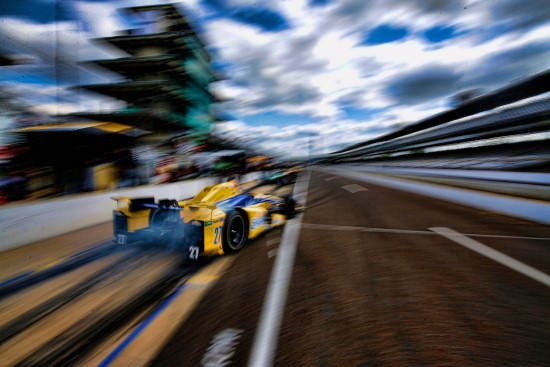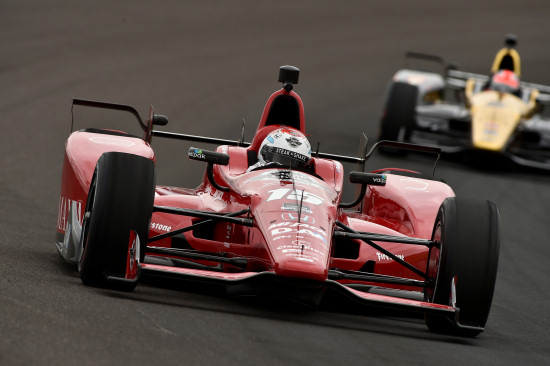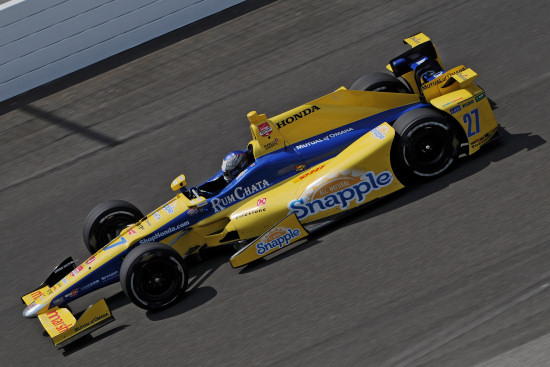The Way It Is/ Can Honda rebound?by Gordon Kirby |
 This year's month of May in Indianapolis was a tough one for Honda. Winners of ten straight Indy 500s from 2003-'12 plus one more with Ryan Hunter-Reay last year, Honda played second fiddle to Chevrolet this year. Chevy swept the top five places in qualifying and the first four in the race with Honda-powered cars leading only seven laps--three with Carlos Munoz, and two each with Justin Wilson and Alex Tagliani--all during pitstops.
This year's month of May in Indianapolis was a tough one for Honda. Winners of ten straight Indy 500s from 2003-'12 plus one more with Ryan Hunter-Reay last year, Honda played second fiddle to Chevrolet this year. Chevy swept the top five places in qualifying and the first four in the race with Honda-powered cars leading only seven laps--three with Carlos Munoz, and two each with Justin Wilson and Alex Tagliani--all during pitstops.
Two days before this year's Indy 500 American Honda's motor sports boss Art St. Cyr discussed the challenges Honda faced at Indianapolis this year during the month of May and in IndyCar as a whole. "Obviously we have some work to do with our kits," St. Cyr admitted. "I think with the Rahal team, we're able to show that we can be fast. But we have some work to do to try to improve our kits to make them more consistent for the way all of our teams want to run the cars. We're working towards doing just that." St. Cyr believes Honda's turbo V6s are equal to Chevrolet's engines on power and may make better fuel mileage.  © LAT USA/Mike Levitt Many people believe Honda was given short shrift by the rule changes that took place at Indianapolis last month following a series of crashes during practice. After Ed Carpenter crashed another Chevy-powered and kitted car on the morning of the first qualifying day, IndyCar decided to mandate a high downforce setup for qualifying. St. Cyr did not attempt to mask Honda's dissatisfaction with IndyCar over the matter. "I think the biggest unfortunate thing is we spent a lot of time working on the aero kits, especially the speedway aero kits," St. Cyr commented. "We feel that we were affected more than we expected to be affected by the rules change that happened. "We put a lot of effort into making sure that our cars were as safe as possible. Obviously we're in a sport where we're pushing the edge of our technical capabilities. There's never a hundred percent guarantee. I asked our partners to put together a list of some of the things we did to ensure the stability of our car and that they're as safe as humanly possible. "If you look at the designs of our car, a lot of our designs were brewed from our vast experience in sports car racing where they have a lot of stability requirements. So things like the big fin on our engine cover, the endplates on our rear wings, the design of the side pods. All of those were designed with stability in mind." "Every class of cars are different. But If you look at our ARX Series, a lot of the design features that you see, the big wings, those types of things, are exactly transferrable from one platform to the other. Now, closed wheel race cars versus open wheel race cars are different aerodynamically, so you can't test the whole package. Honestly, the way the design is done, you're modeling airflow from the very front leading edge of your front wing, all the way to the back. "So the fact that you have completely different styles of vehicles, I think it makes it hard to be able to test on a sports car. But I think concepts transfer very well from one series to another." St.Cyr itemized the hours of computer time HPD engineers logged on its IndyCar aero kits.  © LAT USA/Scott Le Page "We think as much as technologically possible, we developed a vehicle that was better in just about every aspect from a stability standpoint than the DW12 that it replaced. "In some cases the issues that we had [in practice at Indianapolis], we didn't think, from our perspective, that we needed to go to the extremes that were imposed on us. However, for the good of IndyCar, we didn't want to park the cars or do anything like that. "So we agreed to go ahead with qualifying under those situations where we were forced to put parts on the car that were designed specifically for race conditions, that were not appropriate for qualifying situations, things like our winglets that we had on there that necessarily add drag in a situation where you don't need that. "We're just really disappointed that we weren't able to take credit for the work that we did based on the situations that we had." St. Cyr said Honda did a lot of testing for yaw stability. "That is the main reason for the big engine cover that we have and also the end plates, it's mainly for yaw stability," he observed. "What we found in our simulations is actually the 135 degree case is the most likely takeoff scenario. So we did a lot of simulations at the 135 degree case. "Since Helio's incident, we have done an additional 60 CFD runs, and counting, which counts for about 110,000 CPU hours on that. We have done more studies at the 180 degree case and also some elevated cases, as well, going backwards. So, yes, we have taken due care to at least try and study those situations." St. Cyr believes Honda was able to convince IndyCar that its aero kits were well-tested and stable.  © LAT USA/Phil Abbott "I feel that we have demonstrated that our car is safer than the DW12 that preceded it in just about every race situation. We explained that to IndyCar beforehand. I think they believe what we said. But I understand for the good of the sport, we have to make sure and do everything we can to guarantee we don't have cars flying." St. Cyr said Honda expects to make some gains over the course of the season with its road course kits. We designed our kit around the superspeedways so the parts that can't change, things like the engine cover and the side pods, those were designed first and foremost to be most effective on the superspeedway. That was our base platform for our road course. "With our road course performance up 'til now, obviously we want to have better results, and we are working within the rules to make changes as quickly as possible. We do expect to have improvements this year on our road course kits." St, Cyr would have liked to have seen more superspeedway aero kit track testing but believes IndyCar has been unfairly criticized on this count. "The simple answer is the more track testing you do, the more you know the kit," he commented. "But it was even. Both manufacturers had the same number of test days, so we both had the same handicaps. "I think it's safe to say, especially in light of what happened, we would have liked to have had more test days, but those were the rules we knew going in. So to say that we should have had more or not had more is kind of second guessing what we had planned from the beginning." Meanwhile in Detroit last weekend bad weather and changeable track conditions turned both Saturday's and Sunday's races into yellow flag littered games of strategy. On Saturday, Andretti Autosport's Honda-powered cars scored a smart one-two with Carlos Munoz and Marco Andretti as Munoz finally got his first IndyCar win. Sunday's race was won by Sebastien Bourdais's Chevy-powered KVSH Racing car from Takuma Sato and Graham Rahal's Honda-powered machines. But there was plenty of grumbling in Detriot from Honda's teams that Nick Wirth's aero kit is not up to par with Chevy's package. Chevrolet's leading contenders--Juan Montoya, Will Power and Helio Castroneves for Penske and Scott Dixon with Ganassi--ran into a variety of troubles in Detroit but they remain very much the men and teams to beat this year. As Art St. Cyr admitted at the beginning, Honda has some work to do if they're going to prevent Chevy's top teams from dominating this year's Verizon IndyCar series. |
|
Auto Racing ~ Gordon Kirby
Copyright ~ All Rights Reserved |
